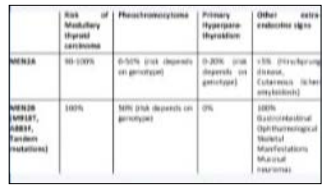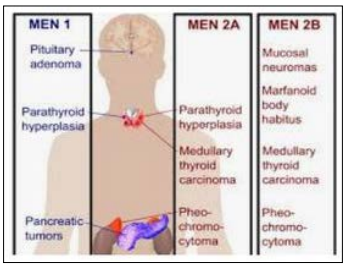Case Presentation MEN2A
Author(s): Hazem Rayyan*, Yousof Al Alawi, Atyya Alzahrani and Ismail Gurbal
Abstract
Multiple endocrine neoplasia type 2 (MEN2) is an autosomal dominant disorder that can be distinguished as three different syndromes: multiple endocrine neoplasia type 2A (MEN2A). MEN2B and familial medullary thyroid carcinoma (FMTC). This disorder is usually caused by the mutations of the rearranged during transfection protooncogene gene (RET) or the neurotrophic tyrosine kinase receptor type 1 gene (NTRK1).
Introduction
Mutations in the E7 proto-oncogene on chromosome 10 have been
identified in MEN 2A MEN 20 and familiallar Mauid carunama
The RET protein is a receptor tyrosine kinase MEN JA and familial
medullary thyroid carcinoma mutations result in activation of
certain intracellular pathways.

Background
MEN2A is subdivided into four phenotypes:
- Classical MEN2AA family (or individual) with at least
two MEN2A clinical features: MTC, PHEO, and/or HPT
(includes: hyperparathyroidism, parathyroid adenoma, or
parathyroid hyperplasia).
- MEN2A with CLAClassical MEN2A family (or individual)
that also developed cutaneous lichen amyloidosis (CLA).
- MEN2A with HSCRClassical MEN2A family (or individual)
that also developed Hirschsprung’s disease (HSCR).
- FMTCFMTC (familial MTC) is used when four or more
family members had MTC only and no clinical evidence of
PHEO, HPT, or any MEN28-specific non-endocrine clinical
features in affected or at-risk family members. Note, FMTC
may be a disease variant of classical MEN2A with decreased
penetrance of PHEO and HPT.
Case report
34years old female patient refered from surgery clinic after
thyroidectomy deo to thyroid nodules found to have medullary
thyroid carcinoma, for follow up, during investigations found to
have high calcitonin, pan CT for staging done, Showed bilateral
adrenal adenomas. While bp is normal, and no palpitations,. 24
hour urine for catecholamins done, found to hve 3 tims upper
normal. Physical examination was normal- no neoromas or other
feturs After discussion with patient and her family dission made
to do bilateral adrenalectomy.Patient started preparation with
phenoxypensanmin, then after 2 weeks of medicine, she underwent
surgery smoothly without complications. Hestopathology came
with diagnosis bilateral pheochromocytoma, Hormonal replasment
with thyroxine and steroids, fludrocortisone started.
Ret protooncogene requested for her came positive, Then requested
for her kids found 3 out 5 kids positive The dissision to do total
thyroidectomy for those who had positive ret mutation [1-4].
Images

Recommendations
- Identify the germline RET mutations in the etiology of
multiple endocrine neoplasia type 2
- Explain the epidemiology of multiple endocrine neoplasia
type 2.
- Review the use of total prophylactic thyroidectomy and lymph
node dissection in the management of multiple endocrine
neoplasia type 2.
- Summarize the importance of collaboration and
communication among the interprofessional team to provide
counseling and genetic testing to first degree relatives of those
affected with multiple endocrine neoplasia type.

References
- Accardo G, Canzo G, Esposito D, Gambardela C, Mazzela
M, et al. (2017) Pasquali D Genetics of medulary thyroid
cancer. An overview. Int J Surg 1: 2-8.
- Brandi ML, Gagel RF, Angel A, Bischian JP, Beck Pecco P,
et al. (2001) Tomasses Tonel Wels SA ir Manx SJ Gusteines
for dagnosis and therapy of MEN type 1 and type 2 J Cin
Endocrinol Metal 12: 568-571.
- Quayle FJ, Molay JF (2000) Medulary thyroid carcinoma:
Including MEN 2A and MEN 28 syndromes J Surg Oncol
89:122-129.
- Wells GA, Drate H (2015) Revised American Thyroid
Association guidelines for the management of medulary
thyroid carcinoma,Thyroid.
View PDF



